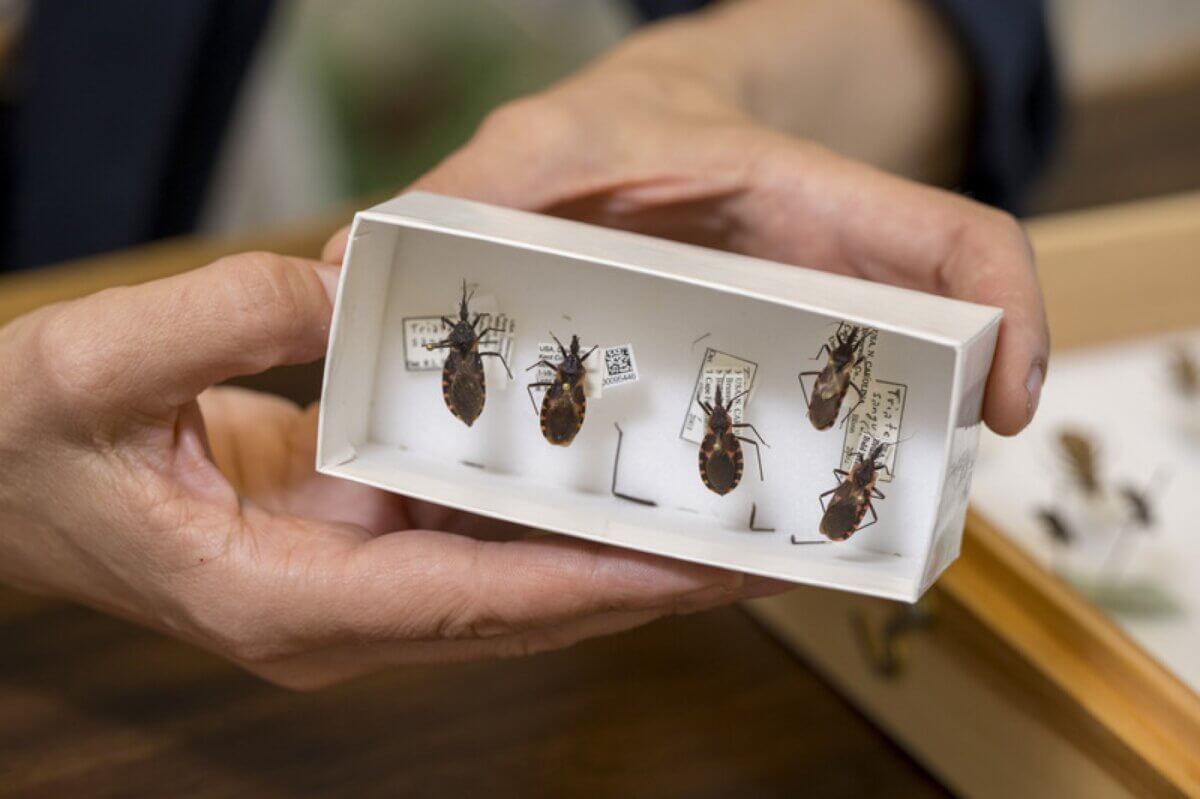
Kissing bugs are vectors of a parasite that causes Chagas disease, which can lead to serious heart problems. (Credit: University of Delaware)
Table of contents
NEWARK, Del. — In a startling discovery that has raised concerns about an emerging public health threat, researchers have reported the first case of a disease-carrying “kissing bug” found inside a home in Delaware. The insect, known to scientists as Triatoma sanguisuga, was not only present in the house but also tested positive for Trypanosoma cruzi - the parasite responsible for causing Chagas disease.
This finding, published in the American Journal of Tropical Medicine and Hygiene, highlights potential gaps in public health awareness and preparedness in the northeastern United States.
Chagas disease, while not widely known in the U.S., affects millions of people in Latin America and is considered a neglected tropical disease by the World Health Organization. The disease can lead to serious heart and digestive system problems if left untreated. While cases of Chagas disease acquired within the United States are rare, this discovery suggests that the risk may be higher than previously thought, especially in areas where the kissing bug's presence has gone unnoticed or understudied.
The case unfolded in New Castle County, Delaware's northernmost and most densely populated region. A homeowner discovered two live adult male kissing bugs in their house - one on a bedroom pillow in July 2023 and another in the kitchen in October of the same year. The discovery set off a months-long journey for the homeowner, who struggled to get accurate information and proper testing for both the insects and themselves.
What makes this case particularly noteworthy is that one of the bugs tested positive for Trypanosoma cruzi. This marks the first recorded instance of an infected kissing bug in Delaware, raising questions about the prevalence of the parasite in local wildlife populations and the potential risk to human health.
“It’s not surprising that it was infected,” says Jennifer Peterson, a UD assistant professor and medical entomologist, in a media release. “It’s more of a wake-up call that this bug needs to be studied.”
The homeowner's experience also sheds light on a critical issue: the lack of awareness and preparedness among healthcare providers and public health officials when it comes to dealing with these insects and the potential for Chagas disease transmission in areas where it's not typically expected.
“If there is not enough food in the forest and a kissing bug sees some twinkling lights coming from someone's house, it’s going to fly in and see if there is a meal,” Peterson warns.

Paper Summary
Methodology
The researchers employed a multi-faceted approach to investigate this case. Their methodology involved several key steps to thoroughly examine the situation. Initially, the insects were identified by the homeowner and later confirmed by entomologists at the University of Delaware as Triatoma sanguisuga. Both insects underwent testing for T. cruzi using real-time PCR (qPCR) techniques to determine if they carried the parasite.
To understand the context of the insect's presence, the researchers conducted a detailed environmental assessment. They gathered information about the home's construction, the surrounding environment, and potential wildlife hosts in the area. This comprehensive approach helped paint a picture of the ecological factors that might contribute to the presence of kissing bugs in the region.
The study also included a medical follow-up component. The homeowner underwent testing for T. cruzi antibodies at a commercial diagnostic laboratory to determine if they had been infected with the parasite.
Lastly, the researchers documented and analyzed the public health response to this incident. They carefully recorded the homeowner's experience in seeking information and assistance from various health and pest control entities. This documentation provided valuable insights into the current state of preparedness and awareness regarding kissing bugs and Chagas disease in the area.
Key Results
The study's findings paint a complex picture of an emerging public health concern. The discovery of two adult male T. sanguisuga inside a well-maintained home in New Castle County, Delaware, was significant as this area had not been previously reported in scientific literature as part of the species' range.
More alarmingly, one of the two insects tested positive for Trypanosoma cruzi, confirming the presence of the Chagas disease parasite in the local kissing bug population. This result raises concerns about the potential for disease transmission in the region.
The environmental assessment revealed that the home was located in an area with a mix of estates, farmland, and forest fragments. This diverse landscape provides potential habitats for both the insects and their wildlife hosts, suggesting that the conditions for a T. cruzi transmission cycle may exist in the area.
From a human health perspective, while the homeowner tested negative for T. cruzi antibodies, they reported experiencing unusual bites and heart palpitations around the time of the bug discoveries. These symptoms, while not definitively linked to the insects, highlight the potential health concerns associated with kissing bug presence.
Perhaps most tellingly, the homeowner's attempt to get information and testing revealed significant gaps in local knowledge and preparedness for dealing with kissing bugs and potential Chagas disease exposure. This finding underscores the need for improved education and protocols in areas where these insects are not typically expected.
Study Limitations
The researchers acknowledged several limitations to their study. The small sample size, with only two insects available for testing, limited the ability to determine the overall prevalence of T. cruzi in the local kissing bug population. Additionally, the study's focus on a single household in one county makes it difficult to generalize findings to the broader region.
Another limitation was the lack of testing of local wildlife for T. cruzi, which could have provided valuable information about the parasite's presence in potential reservoir species. The study also did not include long-term monitoring of the household or surrounding area for continued kissing bug presence or additional T. cruzi infections.
Lastly, while the study highlighted gaps in the public health response, it did not conduct a comprehensive evaluation of local and state preparedness for dealing with kissing bugs and Chagas disease. This broader assessment could have provided more context for the observed challenges in responding to this incident.
Discussion and Takeaways
This case study has several important implications for public health, medical practice, and future research. The presence of kissing bugs in New Castle County suggests that the species' range may be expanding northward, possibly due to factors like climate change or habitat alteration. The detection of T. cruzi in one of the bugs indicates that the parasite is circulating in the local environment, likely among wildlife hosts.
The homeowner's difficulty in obtaining accurate information and appropriate testing highlights a need for increased awareness and education among healthcare providers and public health officials in areas where kissing bugs are not typically expected. The bugs' ability to enter a well-maintained home suggests that traditional risk factors for kissing bug infestations may not apply in all cases, necessitating a reevaluation of prevention strategies.
The study underscores the importance of implementing systematic surveillance for both kissing bugs and T. cruzi in regions where they have not been traditionally monitored. It also exemplifies the interconnectedness of human, animal, and environmental health, emphasizing the need for a One Health approach to addressing vector-borne diseases like Chagas.
For healthcare providers in the northeastern United States, this case suggests they may need to consider Chagas disease as a potential diagnosis in patients with compatible symptoms and potential exposure to kissing bugs. The study also highlights several areas for future research, including the ecology of kissing bugs in the northeast, T. cruzi prevalence in local wildlife, and the development of more effective public health responses to kissing bug encounters.
The discovery of a T. cruzi-infected kissing bug in a Delaware home serves as a wake-up call for public health officials, healthcare providers, and researchers. As climate change and habitat alterations continue to shift the ranges of disease vectors, it's crucial to remain vigilant and adaptable in our approach to emerging infectious disease threats.










